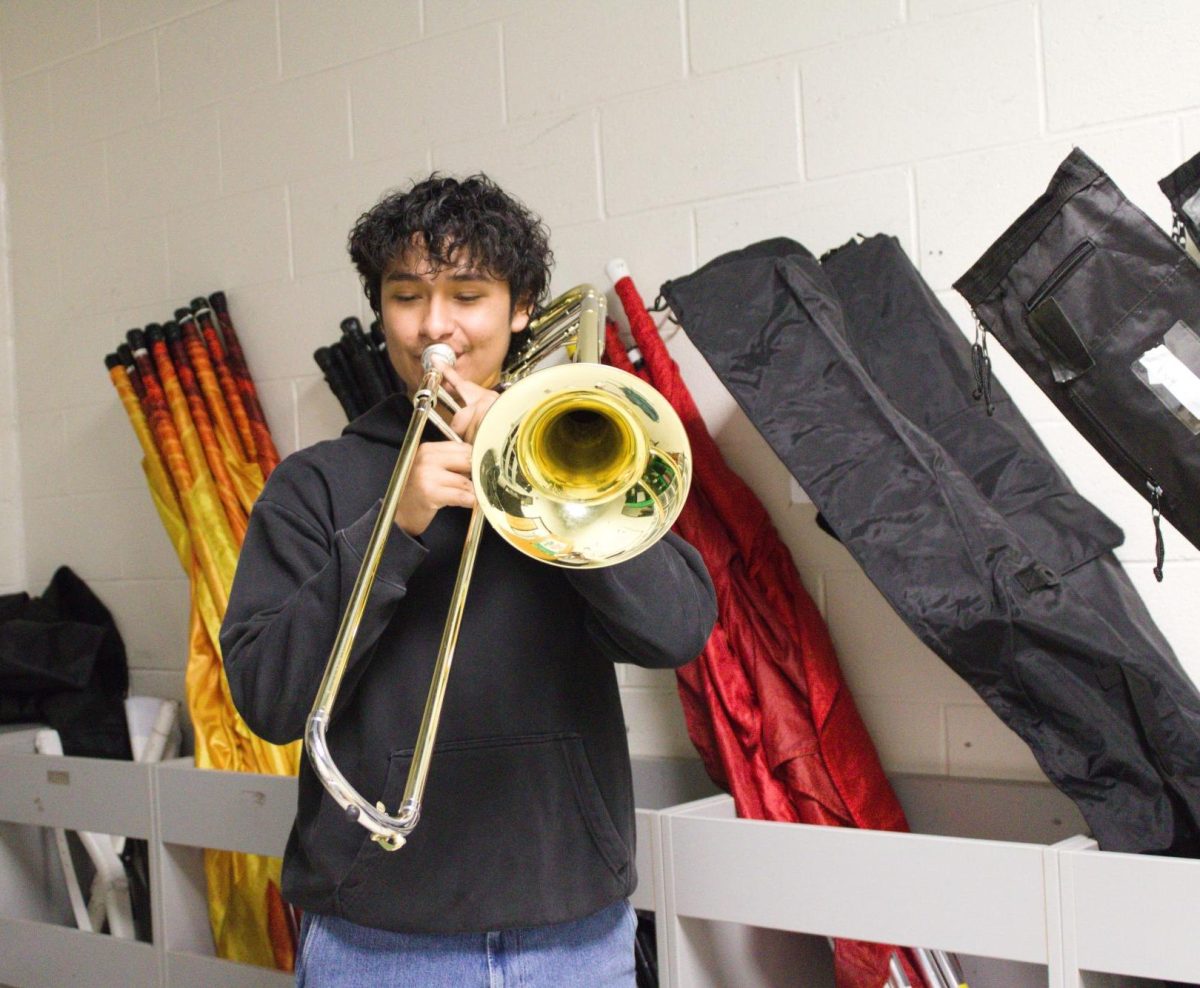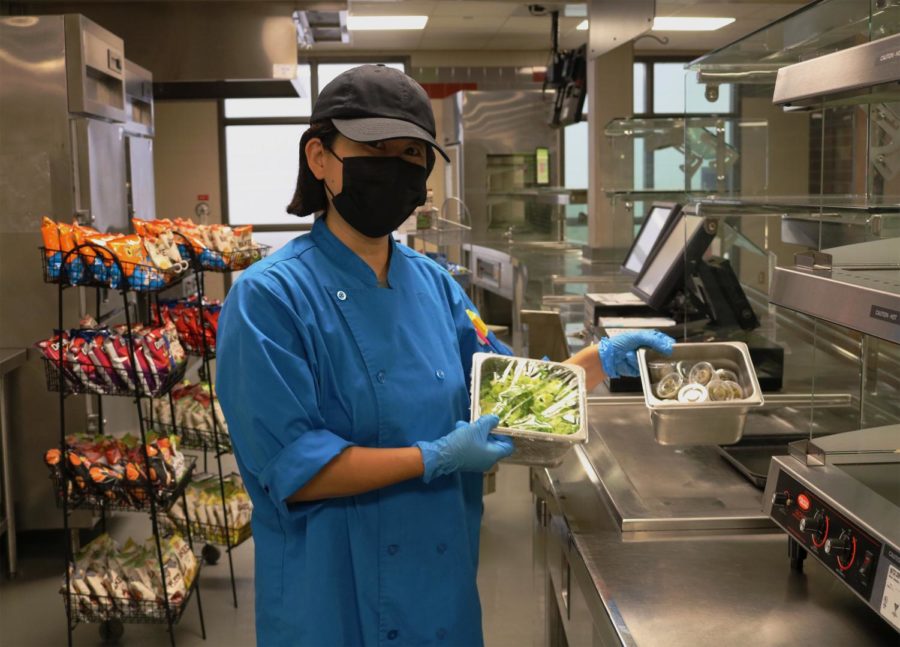Space at the Table: Plating Politics and Perspective in School Lunch
End of federally funded universal free lunch tells stories of food access in post-pandemic recovery
Catharine Li
Cafeteria worker Chiharu Sato explains the various ingredients that are portioned and prepared ahead of daily lunch service. District policy instructs students to select three to five components from whole grains, protein, fruit, vegetables, and milk to create their lunch.
October 10, 2022
Scenes of a school cafeteria at rush hour depict a predictable scramble. The kind of measured chaos that fizzles out just as it begins to mount, conjuring vivid recollections of the experiences that punctuate a seven-hour day: grievances about cardboard pizza among other things, and the small, passing interactions shared weaving between backpacks, suspended in time.
In the come and go of students who build these cyclical routines to embed in otherwise unpredictable days, the cafeteria is a place where procedures are homogenous, and optimized with a linear efficiency.
But the $3.05 withdrawn on Wednesday does not look the same as the $3.05 withdrawn on Friday, a precursor to weekends where going hungry is a striking reality that many students face when meals are not guaranteed in a scheduled manner.
School lunch is highly contested precisely because of what it symbolizes. For what a styrofoam tray can tell us about public institutions, and the layered responsibilities they hold to ensure equitable food access.
Enduring challenges in school nutrition elevate larger issues
Pandemic relief granted by extensive policy change addressed the onslaught of crises sustained in conjunction with virus spread. For one, the convenience of securing a school meal found new meaning when served free of charge, further easing transitional procedures for families through economic disruptions, regardless of income. With the expiration of the Universal School Meals Program this year, the federal government restored the traditional focus placed on low-income students and families through the free and reduced lunch program.
During the 2019-2020 academic year at Westwood, 71,140 lunches were consumed over 128 days, a period shortened by school closures in March. Numbers for the 2021-2022 school year closed out at 144,731 lunches over 168 total instruction days.

“Providing free meals to all meant parents had one less thing to worry about during unprecedented times,” RRISD Food Director Yana Koleva said. “Meal participation increased drastically, and many students, for the first time, were able to enjoy school breakfast and lunch every day.”
In addition to free lunch throughout the school year, the introduction of summer meal programs across the country affirmed the necessity to indiscriminately provide nutritious food with consistency. Once schools shuttered for the summer, other essential services also closed their doors, proving detrimental to economically disadvantaged and food insecure students.
Under the USDA’s Seamless Summer Option (SSO) Program, Round Rock ISD offered free meals to all students on staggered dates from June 6 to July 29 at ten approved campuses across the district. Previous “grab-and-go” systems implemented at the start of the pandemic expired at the end of the 2021-2022 school year. An extension of federal funding through the Keep Kids Fed Act in July brought back “non-congregate” meal distribution and thus, additional accessibility afforded by parent pick-up options.
While Westwood was not designated as a campus that would provide summer meals this year, feeder school Anderson Mill Elementary served a total of 4,933 breakfast meals and 3,139 lunches during a brief 19-day reporting period beginning in June. Roughly half of Anderson Mill’s total student population of 480 was deemed economically disadvantaged during the 2020-2021 academic year.
Assumptions regarding the composition of those served would likely point to a more diverse community of students, including those who attend the elementary school itself, and other feeder campus attendees. Comparatively, Westwood, which served as a “COVID-Grab-and-Go” or CVGG meal location in June and July 2021 distributed a total of 4,109 breakfast meals and 4,276 lunches during a 29-day reporting period.
Absent from the aforementioned statistics is a recognition of the sourcing processes that child nutrition departments must adhere to before meals are assembled in a cafeteria. Just as food access disparities deepened over the past two years, institutions too, felt the strain of rising food costs.
Soaring expenses, coupled with inadequate staffing and meager pay made the rounds throughout public education. Auxiliary staff, who make up 20.7 percent of all district employees, are the second-largest share of RRISD personnel, following teachers at 53.8 percent. School nutrition, custodial services, transportation, and maintenance work are critical to individual campus operations, and all fall within the auxiliary staff grouping. Receiving just under $23,000 per year, the average base salary for a district food service cook only comes down to around $630 per week.

(Catharine Li)
“Labor shortages and supply chain disruptions were the largest challenges we faced this past year,” Koleva said. “These two factors made us realize that we needed to reevaluate our menu plan. Our team came together to simplify our menu offerings while still ensuring compliance with the federal meal pattern.”
In determining the efficacy of school meal participation through pandemic times, federal aid was not enough to curb supply chain disruptions. Consequently, ingredient substitution such as the vegetarian burgers that replaced traditional meat options became commonplace.
“We often did not know what items from our order would fill until the day before the delivery was set to arrive, so we became flexible,” Koleva said.
District funding allocated towards food services have hovered over the latter end of $19 million for the past five years. Telling of constraints imposed by limited preparation time and high demand, discourse concerning the nutritional value supplied by school lunches diverges upon evaluating foods with higher sodium and fat content to reduce costs and appeal to a larger palate. Out of eight primary lunch entree options offered at Westwood, the ‘black forest chicken ham and cheese sandwich’ alone contains 1030 mg of sodium, which accounts for almost half of the recommended daily sodium intake of 2,300 mg for individuals aged 14-18.
Albeit the general appreciation for existing resources and their associated allocation, school lunch program participants amplify a desire for a greater variety of healthy menu offerings.
“I think [accessibility of options] should definitely be a bigger concern at this school,” Andrew Allen ‘26 said. “I have food allergies. Thankfully, they are aware of that, and they cook accordingly, so I have never been exposed to any [allergens].”
Community solutions to food insecurity champion diversity of need
Though ensuring this operational ease requires a standardized menu lineup, many student support services harness a situational awareness that acknowledges the complexity of holistic wellbeing, and what obstructs it. Individualized accommodations, particularly for students disadvantaged by demographic labels in education, often resemble a number of resources.
Creating these multimodal spaces for learning is apparent in areas such as the English as a Second Language (ESL) Department, where class time transcends solely reaching English literacy. Since identifying intensified student needs, the additional snack items made available to ESL students throughout the day are purchased by Mrs. Kathryn Munoz and Ms. Gail Ouda themselves.
“Some of the students that are from Pakistan are the ones that really have trouble with the food. We had one student who just couldn’t eat the food here because of it [containing] processed [ingredients],” Mrs. Munoz said.
Although assistance to students is extended in their best interest, it often fails to consider the discrepancies that hide behind the magnitude of need. Response, when contextualized, can better refine collaboration seeking to serve economically disadvantaged students.
“We send bags of food home on the weekends for students, and we work with the food pantry,” Mrs. Munoz said. “There are community efforts to donate food, and we disperse it. It’s not very much, and it’s not always the kind of food they eat, [for example] canned Spaghetti O’s, [given] some people don’t even have can openers. They wouldn’t know how to use it.”
Ms. Trissa Williams, a social worker for the Westwood learning community, amplifies these sentiments, advocating for more informed decision-making when it comes to meeting the specificity of dietary restrictions. Acknowledging that while any donation made is valued and utilized carefully by the organizing entity, what is reasonable for one individual does not prove all-encompassing for another.
“People are very well-intentioned in donating certain kinds of foods,” Ms. Williams said. “But who is benefiting from those foods? While someone might think it’s great to donate, say, canned meat, some of the people who are using that service may be vegetarian for religious or cultural reasons. It may not be serving the individuals who need it.”
Making appropriate use of an item is only half of the picture. One’s access to a particular service is strengthened through physical proximity, vastly affecting the degree to which consumption of the resource can be reliable without compromise.
“For families who are trying to work and also get access to these resources, it is a challenge with a full-time job, because they operate during typical business hours,” Ms. Williams said. “Sometimes I hear from families, ‘Yeah, these resources are great, but if I take off work to go get the resource I need, then my income is cut.’”
Since 2018, an on-campus food bank has supported food-insecure students. Stocked with donations from members of the National Honor Society (NHS) and a local organization called Hope Austin, this non-profit also provides need-based meal kits that are delivered weekly. Serving 3,000 students each week, Round Rock ISD is their largest service area, one of six other school districts.
“Prior to COVID-19, we were barely scratching the surface of the unseen needs that were going on,” HopeAustin Founder and Executive Director Monica von Waaden said. “When COVID hit, it amplified and magnified them.”
For von Waaden, the continuity of factors contributing to food insecurity parallel the preventable logistical difficulties that arose in the immediacy of the free lunch program’s expiration. A drop in overall school meal participation, per Koleva, is expected for this school year.
Despite attempts from the district to communicate such changes, senior Leena Mir-Hussain’s perspective on the move back to a traditional application-based program magnifies inequities persistent in the eligibility system.
“I’ve been having [free] lunch for almost four years because I cannot afford the lunch every day,” Mir-Hussain said. “Before, they gave us paper [applications], so it was a lot easier, but now that it’s online, it’s making it an issue.”
Notably, the shift to a digital management system has not alleviated wait times. Accompanied by differing levels of internet access, a processing period that can already take up to ten working days confronts other organizational hurdles. Submitted applications must first make their way through the RRISD Food Services Department and later, to the State Agriculture Department.
Reclaiming statistical identity to eliminate disparities in resource distribution
A student’s growth through the education system can hardly be described as static. The responsibilities tethered to academic success are not divorced from navigating the identities shaped by such institutions. For multilingual youth, this is especially true through exposure to culturally conflicting material. Assuming this balance involves delicate interactions with parents or guardians along the lines of language, which is obscured further by the informality of often emotionally demanding translation work.
“We’ve been sitting down with each of our students, showing them the [free and reduced lunch application] and how to fill it out,” Ms. Munoz said. “There’s a lot of information that only their parents can give. We make sure our students can help their parents do that. In different cultures, there are different roles that parents play, and in some cultures, it’s not the parent’s place to question anything.”
Data, as published through the Texas Academic Performance Report (TAPR), assesses student demographics alongside other state-identified standards of academic achievement and accountability, including STAAR testing results and enrollment. Reports are released in November, and consist of information concerning the previous academic year.
Just prior to the pandemic, nearly 26 percent of all students attending Round Rock ISD schools were eligible for free or reduced lunch. At Westwood, 306 students from economically disadvantaged households made up 10.7 percent of the total student population during 2019-2020. This figure rose to 14.9 percent of the student body for the following school year, marking a staggering 39 percent increase.
Funded by the National School Lunch Program (NSLP), eligibility for free and reduced lunch is based on income and size of family. Between 130 and 185 percent of the federal poverty line can a student qualify for reduced-price lunch, with those at or below the 130 mark receiving a free lunch.

Statistics collected through free and reduced lunch have long been held as a proxy for economic vulnerability, but are not a comprehensive assessment of students with such backgrounds. In the case of multi-generational households fending against these financial technicalities—namely, individuals living with extended family, they are often unable to claim those they may be providing for as dependents for income tax purposes under constraints from baseline criteria that filters eligibility through immigration status or ‘qualifying’ relations.
“I think about families who are doubled up for cultural or financial reasons,” Ms. Williams said. “There might be more individuals in the house that they’re not able to record, even though they are providing for them.”
A student who is at risk of dropping out of school aligns with one or more of 13 total characteristics as prescribed by the Texas Education Agency (TEA). Among one of these criteria is an emergent bilingual student “whose primary language is other than English and whose English language skills are such that the student has difficulty performing ordinary classwork in English.”
Such explicit connections drawn between language fluency and economic vulnerability highlight the certain concessions made in interpreting the intersections between data and policy-making. Many ESL teachers, including those at Westwood, assume the role of a case manager, working closely with related support departments to keep detailed records of student progress alongside language acquisition.
“Not all students who are ESL are necessarily economically disadvantaged,” Ms. Williams said. “We don’t want to over-identify, but we also don’t want to miss out on any students who do need that [support].”
Investing in the singularity of student experience insists on a conscious reckoning with the contexts that may inform, but do not define one’s story.
“As professionals, as educators, and [as] people working with anybody, we have to check ourselves to make sure we’re always doing what’s in the best interest of the student or family, and giving them the respect and dignity to make that choice for themselves,” Ms. Williams said.
Preserving this autonomy in the processes by which food is distributed through is a medium for destigmatization, and a key facet of the HopeAustin service model. Crucially, the very notions of access that tend to antiquate perceptions of a student’s mobility when deciding how and when to use these resources can be alleviated by normalizing discussion of the specific elements that both sustain and compound circumstantial hardship.
“All children have to go to school, and they are a captured audience at each one of our campuses,” von Waaden said. “If we can get food to the children, and put it in their backpacks in a dignified and respectful way, that takes the accessibility component out of food insecurity.”
Distinguishing where pre-pandemic assertions continue to cloud current realities is difficult, and mirrors attitudes towards the multicausality of issues plaguing food access. Better navigating the expanse of these barriers calls for confrontation: of uncomfortable truths that are engrained systematically into procedural habit and what nuances enhance perspective, resonating beyond polarity.
This story was originally published on Westwood Horizon on October 2, 2022.





































